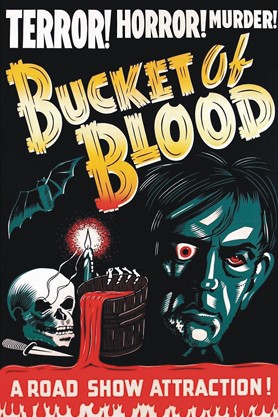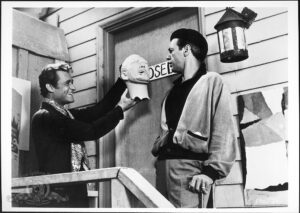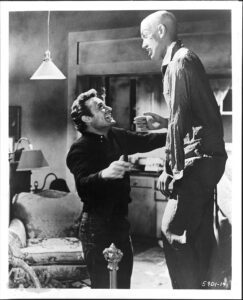 This 49 minute British shocker is nearly ninety years old, yet remains an astonishing example of expressionistic filmmaking. Not to be mistaken for the similarly titled Roger Corman cheapie, this is an adaptation of “The Tell-Tale Heart” by Edgar Allan Poe, 1934’s BUCKET OF BLOOD (also known as THE TELL-TALE HEART) can be viewed as the UK’s answer to THE CABINET OF DR. CALIGARI, dealing as it does with similar subject matter—namely murder and subjectively portrayed insanity.
This 49 minute British shocker is nearly ninety years old, yet remains an astonishing example of expressionistic filmmaking. Not to be mistaken for the similarly titled Roger Corman cheapie, this is an adaptation of “The Tell-Tale Heart” by Edgar Allan Poe, 1934’s BUCKET OF BLOOD (also known as THE TELL-TALE HEART) can be viewed as the UK’s answer to THE CABINET OF DR. CALIGARI, dealing as it does with similar subject matter—namely murder and subjectively portrayed insanity.
Featured is an unnamed young man in an insane asylum. This guy suffers, apparently, from a severe case of “delusional insanity,” having covered the walls of his cell with drawings of leering eyes. The man, however, assures the asylum overseers that he’s not actually insane, and to prove it recounts the circumstances of how he ended up therein. An extended series of dissolve-heavy flashbacks show that he was living in a creaky old house, where he was cared for by a creepy old man.
This coot has an especially ugly, leering eye, and a heart whose beating the protagonist believes he can hear. He becomes obsessed with killing the old man, and before long does just that, after which he stashes the corpse beneath the floor of his living room. He, however, still sees the old man’s eyes everywhere, and—as he unwisely confesses to a pair of police officers investigating reports of a scream heard emitting from the house—continues to hear “the beating of his hideous heart!”
This film does admittedly drag a bit in its latter scenes, but the haunting charge built up by the earlier ones carries through to the end. The dialogue, taken directly from the Poe text, is notably flat, and spoken without much inflection by the actors. The emphasis throughout is on visual design, with the performances, particularly that of the lead actor Norman Dryden (whose only screen credit this was), oriented toward facial expressions—which in Dryden’s case means a lot of overwrought glowering redolent of silent movie acting.
From a pictorial standpoint BUCKET OF BLOOD outdoes any of the CABINET OF DR. CALIGARI wannabes (such as GENUINE and THE ETERNAL MASK) that appeared in the two decades following that iconic film’s 1920 release. Director Brian Desmond Hurst displays a visual confidence and bravura that belay the fact that this was his feature debut (he’d go on to direct many more films, including classics like ALIBI and the 1951 version of A CHRISTMAS CAROL). In addition to CALIGARI, a comparison can be made to the work of Hurst’s fellow countryman Alfred Hitchcock, a filmmaker who was also heavily influenced by German expressionism, and also utilized it quite brilliantly.
Vital Statistics
BUCKET OF BLOOD (THE TELL TALE HEART)
Fox British Pictures Ltd.
Director: “Desmond Hurst” (Brian Desmond Hurst)
Producer: Harry Clifton
Screenplay: David Plunkett Greene, Brian Desmond Hurst
(Based on a story by Edgar Allan Poe)
Cinematography: Walter Blakely, Brian Desmond Hurst
Editing: Vernon J. Clancey
Cast: Norman Dryden, John Kelt, Yolande Terrell, Thomas Shelton, James Fleck, Colonel Cameron, H. Vasher


